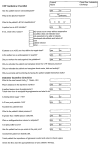A comparison of in-person home care, home care with telephone contact and home care with telemonitoring for disease management
- PMID: 19815903
- PMCID: PMC2882290
- DOI: 10.1258/jtt.2009.090118
A comparison of in-person home care, home care with telephone contact and home care with telemonitoring for disease management
Abstract
We compared the effects of evidence-based disease management guidelines delivered to patients with heart failure and diabetes using three different modalities: in-person visits alone (Control), in-person visits and a telephone intervention (Telephone), and in-person visits and telemonitoring (Telemonitoring). Patients were randomized to the three groups. There were 112 patients in the Control group, 93 in the Telephone group and 98 in the Telemonitoring group. During the first 60 days, 10% of the Control group were rehospitalized, 17% of the Telephone group and 16% of the Telemonitoring group. Having heart failure and receiving more in-person visits were significantly related to readmission and time to readmission. However, after adjusting for diagnosis and visits, the differences between the three groups were non-significant. There was a trend for increased risk of readmission for the Telephone group compared to Control alone (P = 0.07, risk ratio 2.2, 95% CI: 0.9 to 5.2) and for readmission sooner (P = 0.02, risk ratio 2.3, 95% CI: 1.2 to 4.6). Patient rehospitalization and emergency department visit rates were lower than the national average, making it difficult to detect a difference between groups. Previous rehospitalization was a consistent predictor of those who were rehospitalized, suggesting that it may be a useful indicator for identifying patients likely to need additional attention.
Figures
References
-
- Centers for Disease Control and Prevention. Health, United States. 2007. See http://www.cdc.gov/nchs/data/hus/hus07.pdf (last checked 11 May 2009)
-
- Merck Institute of Aging and Health. The Slate of Aging and Health in America. 2004. See http://www.cdc.gov/aging/pdf/State_of_Aging_and_Health_In_America_2004.pdf (last checked 11 May 2009)
-
- Alliance for Aging Research. The Silver Book. See http://www.silverbook.org/fact/30 (last checked 11 May 2009)
-
- Robert Wood Johnson Foundation. Chronic Care in America: A 21st Century Challenge. See http://www.rwjf.org/files/publications/other/ChronicCareinAmerica.pdf (Qast checked 11 May 2009)
Publication types
MeSH terms
Grants and funding
LinkOut - more resources
Full Text Sources
Medical



